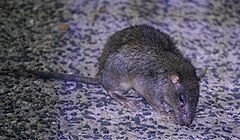Szczurowiec
| Uromys | |||
| W. Peters, 1867[1] | |||
 Przedstawiciel rodzaju – szczurowiec białoogonowy (U. caudimaculatus) | |||
| Systematyka | |||
| Domena | |||
|---|---|---|---|
| Królestwo | |||
| Typ | |||
| Podtyp | |||
| Gromada | |||
| Podgromada | |||
| Infragromada | |||
| Rząd | |||
| Podrząd | |||
| Infrarząd | |||
| Nadrodzina | |||
| Rodzina | |||
| Podrodzina | |||
| Plemię | |||
| Rodzaj |
szczurowiec | ||
| Typ nomenklatoryczny | |||
|
Mus macropus J.E. Gray, 1866 (= Hapalotis caudimaculatus Krefft, 1867) | |||
| Synonimy | |||
|
| |||
| Podrodzaje i gatunki | |||
| |||
Szczurowiec[5] (Uromys) – rodzaj ssaków z podrodziny myszy (Murinae) w obrębie rodziny myszowatych (Muridae).
Zasięg występowania[edytuj | edytuj kod]
Rodzaj obejmuje gatunki występujące w Australii i na Nowej Gwinei[6][7][8].
Morfologia[edytuj | edytuj kod]
Długość ciała (bez ogona) 170–382 mm, długość ogona 130–400 mm, długość ucha 16–40 mm, długość tylnej stopy 37–80 mm; masa ciała 170–1020 g[7][9].
Systematyka[edytuj | edytuj kod]
Rodzaj zdefiniował w 1867 roku niemiecki zoolog Wilhelm Peters na łamach Monatsberichte der Königlichen Preussische Akademie des Wissenschaften zu Berlin[1]. Na gatunek typowy Peters wyznaczył szczurowca białoogonowego (U. caudimaculatus).
Etymologia[edytuj | edytuj kod]
- Uromys: gr. ουρα oura ‘ogon’; μυς mus, μυος muos ‘mysz’[10].
- Gymnomys: gr. γυμνος gumnos ‘goły, nagi’; μυς mus, μυος muos ‘mysz’[11]. Gatunek typowy: Mus macropus J.E. Gray, 1866 (= Hapalotis caudimaculatus Krefft, 1867).
- Cyromys: gr. κυρος kuros ‘siła, władza’[12]; μυς mus, μυος muos ‘mysz’[13]. Gatunek typowy (oryginalne oznaczenie): Mus imperator O. Thomas, 1888
- Melanomys: gr. μελας melas, μελανος melanos ‘czarny’; μυς mus, μυος muos ‘mysz’[4]. Gatunek typowy (oznaczenie monotypowe): Melomys hadrourus Winter, 1983.
Podział systematyczny[edytuj | edytuj kod]
Do rodzaju należą następujące gatunki zgrupowane w podrodzajach[14][9][6][5]:
- ?
- Uromys siebersi O. Thomas, 1923 – szczurowiec wyspowy
- Uromys W. Peters, 1867
- Uromys neobritannicus Tate & Archbold, 1935 – szczurowiec pustelniczy
- Uromys anak O. Thomas, 1907 – szczurowiec czarnoogonowy
- Uromys boeadii Groves & Flannery, 1994 – szczurowiec mały
- Uromys emmae Groves & Flannery, 1994 – szczurowiec samotny
- Uromys caudimaculatus (Krefft, 1867) – szczurowiec białoogonowy
- Uromys hadrourus (Winter, 1984) – szczurowiec maskowy
- Cyromys O. Thomas, 1910
- Uromys vika Lavery & Judge, 2017
- Uromys imperator (O. Thomas, 1888) – szczurowiec cesarski
- Uromys porculus O. Thomas, 1904 – szczurowiec żarłoczny
- Uromys rex (O. Thomas, 1888) – szczurowiec królewski
Opisano też gatunek wymarły z plejstocenu dzisiejszego stanu Queensland w Australii[15][16]:
- Uromys aplini Cramb, Hocknull & Price, 2020
Uwagi[edytuj | edytuj kod]
- ↑ Młodszy homonim Melanomys O. Thomas, 1902 (Cricetidae); nomen nudum.
Przypisy[edytuj | edytuj kod]
- ↑ a b W. Peters. Eine neue gattung von nagern, Uromys, aus Nordaustralien. „Monatsberichte der Königlichen Preussische Akademie des Wissenschaften zu Berlin”. Aus dem Jahre 1867, s. 343, 1867. (niem.).
- ↑ J.E. Gray. Notes on the variegated or yellow-tailed rats of Australasia. „Proceedings of the Zoological Society of London”. 35, s. 597, 1867. (ang.).
- ↑ O. Thomas. New genera of Australasian Muridæ. „The Annals and Magazine of Natural History”. Eighth Series. 6, s. 507, 1910. (ang.).
- ↑ a b J.W. Winter: Thornton Peak Melomys. W: R. Strachan (red.): The Australian museum complete book of Australian mammals (The national photographic index of Australian wildlife). Sydney: Angus & Robertson, 1983, s. 379. ISBN 0-207-14454-0. (ang.).
- ↑ a b Nazwy polskie za: W. Cichocki, A. Ważna, J. Cichocki, E. Rajska-Jurgiel, A. Jasiński & W. Bogdanowicz: Polskie nazewnictwo ssaków świata. Warszawa: Muzeum i Instytut Zoologii PAN, 2015, s. 282–283. ISBN 978-83-88147-15-9. (pol. • ang.).
- ↑ a b C.J. Burgin, D.E. Wilson, R.A. Mittermeier, A.B. Rylands, T.E. Lacher & W. Sechrest: Illustrated Checklist of the Mammals of the World. Cz. 1: Monotremata to Rodentia. Barcelona: Lynx Edicions, 2020, s. 498–500. ISBN 978-84-16728-34-3. (ang.).
- ↑ a b Ch. Denys, P. Taylor & K. Aplin. Opisy gatunków Muridae: Ch. Denys, P. Taylor, C. Burgin, K. Aplin, P.-H. Fabre, R. Haslauer, J. Woinarski, B. Breed & J. Menzies: Family Muridae (True Mice and Rats, Gerbils and relatives). W: D.E. Wilson, R.A. Mittermeier & T.E. Lacher (redaktorzy): Handbook of the Mammals of the World. Cz. 7: Rodents II. Barcelona: Lynx Edicions, 2017, s. 715–718. ISBN 978-84-16728-04-6. (ang.).
- ↑ D.E. Wilson & D.M. Reeder (redaktorzy): Genus Uromys. [w:] Mammal Species of the World. A Taxonomic and Geographic Reference (Wyd. 3) [on-line]. Johns Hopkins University Press, 2005. [dostęp 2020-12-10].
- ↑ a b Class Mammalia. W: Lynx Nature Books: All the Mammals of the World. Barcelona: Lynx Edicions, 2023, s. 320–321. ISBN 978-84-16728-66-4. (ang.).
- ↑ Palmer 1904 ↓, s. 702.
- ↑ Palmer 1904 ↓, s. 303.
- ↑ Brown 1954 ↓, s. 250.
- ↑ Brown 1954 ↓, s. 544.
- ↑ N. Upham, C. Burgin, J. Widness, M. Becker, C. Parker, S. Liphardt, I. Rochon & D. Huckaby: Treeview of Mammalian Taxonomy Hierarchy. [w:] ASM Mammal Diversity Database (Version 1.11) [on-line]. American Society of Mammalogists. [dostęp 2023-10-12]. (ang.).
- ↑ J. Cramb, S.A. Hocknull & G.J. Price. Fossil Uromys (Rodentia: Murinae) from central Queensland, with a description of a new Middle Pleistocene species. „Records of the Australian Museum”. 72 (5), s. 175–191, 2020. (ang.).
- ↑ J.S. Zijlstra, Uromys aplini Cramb, Hocknull & Price, 2020, Hesperomys project (Version 23.8.1), DOI: 10.5281/zenodo.7654755 [dostęp 2023-10-12] (ang.).
Bibliografia[edytuj | edytuj kod]
- T.S. Palmer. Index Generum Mammalium: a List of the Genera and Families of Mammals. „North American Fauna”. 23, s. 1–984, 1904. (ang.).
- R.W. Brown: Composition of scientific words; a manual of methods and a lexicon of materials for the practice of logotechnics. Washington: Published by the author, 1954, s. 1–882. (ang.).
